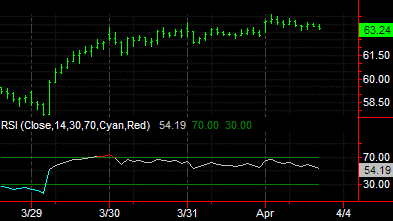 RSI (Indicator)
RSI (Indicator)

Input Information
| Name | Expression | Default | Description |
| Price | Numeric | Close | Price used in calculation of RSI. |
| Length | Numeric | 14 | Number of bars to include in the calculation. |
| OverSold | Numeric | 30 | RSI level considered as oversold. |
| OverBought | Numeric | 70 | RSI level considered as overbought. |
| OverSColor | Numeric | Cyan | Color used when RSI is below the OverSold level. |
| OverBColor | Numeric | Red | Color used when RSI is above the OverBought level. |
Market Synopsis
The Relative Strength Index (RSI) indicator calculates a value based on the cumulative strength and weakness of price, specified in the input Price, over the period specified in the input Length. For that number of bars, RSI accumulates the points gained on bars with higher closes and the points lost on bars with lower closes. These two sums are indexed, with the index plotted on the chart. The RSI plots as an oscillator with a value from 0 to 100. The direction of RSI should confirm price movement. For example, a rising RSI confirms rising prices.
RSI can also help identify turning points when there are non-confirmations or divergences. For example, a new high in price without a new high in RSI may indicate a false breakout. RSI is also used to identify overbought and oversold conditions when the RSI value reaches extreme highs or lows. This indicator automatically changes the color of the RSI plot when it exceeds either of the levels specified in the inputs OverSold and OverBought. Horizontal reference lines are also plotted at these levels as visual aids.
Plot Information
| Number | Name | Default Color | Description |
| Plot1 | RSI | Grey, or as specified by inputs | Plots the RSI value. |
| Plot2 | OverBot | Dark Green | OverBought reference line. |
| Plot3 | OverSold | Dark Green | OverSold reference line. |
When applied to a chart, this indicator displays three plots in a separate subgraph from the price data.